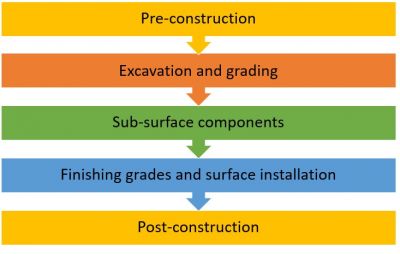Difference between revisions of "Construction"
Kyle menken (talk | contribs) |
Kyle menken (talk | contribs) |
||
| Line 100: | Line 100: | ||
==Post-construction== | ==Post-construction== | ||
Post-construction tasks ensure that the LID practice was built to specs and that any outstanding issues with it are resolved before assumption. The [[post-construction]] page give guidance on: | |||
*Addressing deficiencies | |||
*Final certification | |||
==LID practice pages== | ==LID practice pages== | ||
Revision as of 12:30, 8 August 2022
Overview[edit]
- Importance of construction inspections
- Contractor familiarity & incremental changes in the construction industry
- What you can expect from STEP guidance: practical advice, specific to LID, on how to ensure successful construction
Construction stages and LID types[edit]
STEP divides the construction process for LID practices into five over-arching stages:
- Pre-construction
- Excavation and grading
- Sub-surface components
- Finishing grades and surface layer installation: vegetated LIDs and finishing grades and surface layer installation: permeable pavements
- Post-construction
Most LID practices work at the ground-level by routing stormwater flows from impervious surfaces into excavated or natural depressions or by allowing stormwater to pass through a traditionally impervious surface, as is the case with permeable pavements. These depressions are designed and constructed to the meet goals of the LID practice, which may be quality control, quantity control, or water balance restoration. Bioretention gardens, bioswales, rain gardens, enhanced swales, exfiltration trenches, permeable pavements, and infiltration systems (chambers, trenches, and soakaways) all fall into this category.
For this reason, Stages 1-2 and 5 of the LID construction process are fundamentally similar for all ground-level LID types. To illustrate, STEP's recommended processes for excavation do not differ between LID practice types. Excavation is excavation, whether it is for a bioretention garden or a permeable pavement parking lot. On the other hand, stage 4 sub-tasks will vary depending on whether the LID practice's surface is vegetated or permeable pavement. Some sub-tasks in stage 3 will also vary depending on the LID type. For example, permeable pavements often require compaction of sub-surface storage layers. The following sections give a brief description of each over-arching stage, a list of sub-tasks for each stage, and links to the page dedicated to each main LID construction stage.
Green roofs, blue roofs, stormwater planters, and rainwater harvesting systems have specific construction sequences that differ from the main sequence described above. One day we will write guidance for these LID practices as well.
Pre-construction[edit]
Pre-construction activities set the stage for the successful construction of an LID practice. The pre-construction page gives guidance on:
- design verification and site walk-through
- LID construction notes
- tendering and contract
- communication, inspection plan, and utilities coordination
- erosion and sediment control measures
- mobilization, access, staging, and perimeter controls
Excavation and grading[edit]
Excavation and grading are necessary for installing LID practices with sub-surface components, re-grading land to hold more water, and re-routing overland flow routes into an LID practice. The excavation and grading page gives guidance on:
- clearing and grubbing
- excavation and rough grade
- sub-grade
- final excavated grade and verification
Sub-surface components[edit]
Most LID practices use sub-surface features--gravel storage reservoirs, liners, underdrains, monitoring wells, etc. The construction process for sub-surface components works from the ground up. While some LID practices include all the sub-surface components listed below, most designs will not include one or more of these layers. Permeable pavements can have different construction requirements at this stage, mostly regarding compaction of sub-surface layers. Installing infiltration chambers also requires guidance specific to that LID type.
The backfill granular, utilities, and pipes / sub-surface components page gives guidance on:
- geotextile
- underdrain
- impermeable liners
- overflow
- monitoring wells
- storage reservoir
- sub-base reservoir (permeable pavements)
- base course (permeable pavements)
- infiltration chamber installation
- stone choker layer
- curbing
- pre-treatment and inlet
Finishing grades and surface layer installation[edit]
This construction stage differs between LID practice type. The finishing grades and surface layer installation: vegetated LIDs page has guidance for vegetated LIDs, and the finishing grades and surface layer installation: permeable pavements page has guidance for and non-vegetated LIDs. In many cases the surface of infiltration systems will be traditional asphalt, concrete, or pavers; STEP does not provide guidance on installing non-permeable surfaces.
| LID practices with vegetated surfaces | Permeable pavements |
|---|---|
| soil media installation and soil amendments | bedding layer |
| finish grading | placement and finishing |
| large stone and riprap | paver installation |
| plant verification and installation | tamping |
| mulch placement | joint cutting |
| stabilizing contributing drainage area and planting adjacent vegetation | joint aggregate |
| -- | curbing |
| -- | stabilizing contributing drainage area |
Post-construction[edit]
Post-construction tasks ensure that the LID practice was built to specs and that any outstanding issues with it are resolved before assumption. The post-construction page give guidance on:
- Addressing deficiencies
- Final certification
LID practice pages[edit]
Each construction page listed below :)
8008
